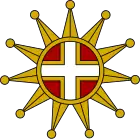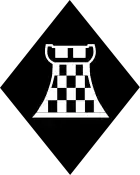XI Corps (United Kingdom)
XI Corps was a corps-sized formation of the [British Expeditionary Force], active during the Great War that served on the Western Front and in Italy. It was recreated as part of Home Forces defending the United Kingdom during World War II.
| XI Corps | |
|---|---|
  XI Corps formation badge WWI (left) and WWII (right). | |
| Active | 1915–1919 1940–1943 |
| Country | |
| Branch | |
| Type | Corps |
| Engagements | World War I[1]
|
| Commanders | |
| Notable commanders | Sir Richard Haking |
First World War
Western Front
XI Corps was formed in France on 29 August 1915 under Lt-Gen Richard Haking.[1] Its first serious engagement (as part of Sir Charles Monro's First Army) was the Battle of Fromelles (19 July 1916), a diversion to the Somme offensive in which two untried divisions were launched into an ill-planned subsidiary attack in Flanders. It achieved nothing but cost thousands of casualties, and caused great resentment in Australia.[2]
- Order of Battle at Fromelles[3]
General Officer Commanding Lt-Gen R. Haking
Italian Front
XI Corps was one of two corps HQs moved to the Italian Front in November 1917.[1]
- Order of Battle in Italy 1 December 1917[4]
GOC Lt-Gen Sir Richard Haking
Corps Troops:
- 1/1st King Edward's Horse
- HQ Corps Heavy Artillery Royal Garrison Artillery (RGA)
- 11th Cyclist Battalion Army Cyclist Corps
- Corps Topographical Section Royal Engineers (RE)
- Signal Troops RE (L Corps Signal Company; 27 (Motor) Airline Section; R and LC Cable Sections, *Corps Heavy Artillery Signal Section RGA)
- Corps Siege Park Army Service Corps (ASC)
- Corps Ammunition Park (345 (MT) Company (25 Ammunition Sub-Park) ASC)
- 491 (MT) Company ASC, attached Corps Heavy Artillery
- 5th (Light) Mobile Workshop Army Ordnance Corps (AOC)
- Area Employment Company
- Corps School
Return to the Western Front
XI Corps returned to the Western Front in March 1918 in time to take part in the defence against the German Spring Offensive (the Battle of the Lys) and the final battles of the war as part of Sir William Birdwood's Fifth Army.
Corps Headquarters Command Staff
- GOC Lt-Gen Sir Richard Haking
- Brigadier-General, General Staff: Brig-Gen J.E.S. Brind
- Deputy Adjutant & Quartermaster-General: Brig.-Gen A.F.U. Green
- Assistant Director Ordnance Services, Lt Col A.J. Herbert, NZAOC[6]
- Commander, Royal Artillery: Brig-Gen S.F. Metcalfe
- Commander, Heavy Artillery: Brig-Gen F.A. Twiss
- Commander, Engineers: Brig-Gen H.J.M. Marshall
Divisions attached to IX Corps
- 19th (Western) Division (to Third Army 4 October)
- 47th (1/2nd London) Division (to III Corps 13 October)
- 57th (2nd West Lancashire) Division (from Third Army 11 October)
- 59th (2nd North Midland) Division
- 61st (2nd South Midland) Division (to Third Army 5 October)
- 74th (Yeomanry) Division (from Fourth Army 2 October; to III Corps 8 October)
Second World War
XI Corps was reformed in the United Kingdom early in the Second World War. It was based at Bishop's Stortford in Hertfordshire[7] with a major operational base at Felsted School.[8]
- Order of Battle Autumn 1940[9]
General Officers Commanding
Commanders included:[12]
- 1915-1918 Lieutenant-General Richard Haking
- Jul 1940-Nov 1941 Lieutenant-General Hugh Massy
- Nov 1941-Mar 1942 Lieutenant-General Noel Irwin
- Mar 1942-Sep 1942 Lieutenant-General John Crocker
- Sep 1942-Apr 1943 Lieutenant-General Gerard Bucknall
- Apr 1943-Jul 1943 Lieutenant-General Gerald Templer
Notes
- Baker, Chris (2010). "The British Corps of 1914-1918". The Long, Long Trail. Retrieved 11 June 2014.
- Baker, Chris (2007). "Fromelles: was the Australian Official History more truthful than the British?". The Long, Long Trail. Retrieved 11 June 2014.
- Baker, Chris (2010). "The Battles of the Somme, 1916". The Long, Long Trail. Retrieved 11 June 2014.
- Baker, Chris (2010). "The British campaign in Italy 1917-1918". The Long, Long Trail. Retrieved 11 June 2014.
- Official History 1918 Volume V, p 125 and Appendix I.
- "Military personnel file". Archway, Archives New Zealand. Retrieved 20 August 2018.
- Newbold, p. 202
- "Wartime Memories". Felsted School. Retrieved 20 February 2016.
- "11 Corps". The Royal Artillery 1939-45. 2014. Retrieved 11 June 2014.
- "147 (Essex Yeomanry) Field Regiment RA (TA)". The Royal Artillery 1939-45. 2014. Retrieved 11 June 2014.
- "72 Medium Regiment RA (TA)". The Royal Artillery 1939-45. 2014. Archived from the original on 3 March 2016. Retrieved 11 June 2014.
- Mackie, Colin (2011). "Army Commands 1900-2011" (PDF). gulabin.com. p. 137. Archived from the original (PDF) on 5 July 2015. Retrieved 11 June 2014.
References
- Newbold, David John. "British planning and preparations to resist invasion on land, September 1939 - September 1940". King's College, University of London.
- Official History 1918: Brigadier-General Sir James E. Edmonds, Military Operations France and Belgium, 1918 Volume V: 26 September–11 November: The Advance to Victory 1947 (reprint Imperial War Museum, 1992) ISBN 1-870423-06-2